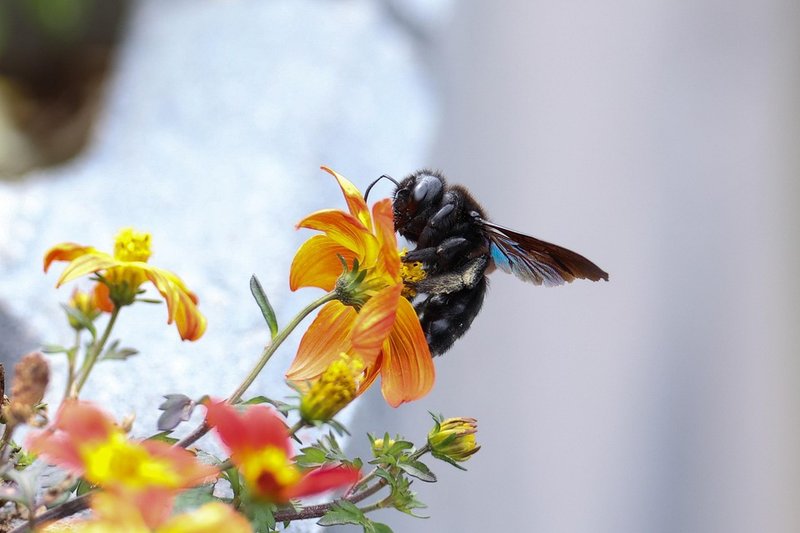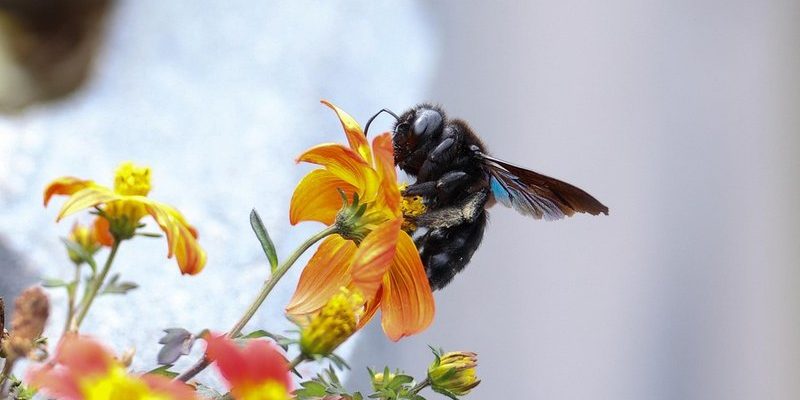
Carpenter bees have a unique skill set that makes them particularly effective pollinators. Unlike honeybees, which are social insects living in large colonies, carpenter bees tend to be more solitary. This independence allows them to visit a wider variety of plants. They don’t just look pretty while buzzing around; they’re essential for the health of our ecosystems as they help plants reproduce. In this article, we’ll explore the fascinating role of carpenter bees in pollination and why they matter to our environment.
What Is Pollination and Why Is It Important?
Let’s start with the basics. Pollination is the process where pollen from the male part of a flower (the anther) is transferred to the female part (the stigma) of the same or another flower. This essential step allows plants to produce seeds and fruits, leading to the regeneration of plant life. Without pollination, many plants wouldn’t be able to reproduce, which would significantly impact our food supply and the natural world around us.
Now, you might be wondering why this matters. According to the Food and Agriculture Organization (FAO), about 75% of the world’s food crops depend on pollinators. That’s a staggering number! So, when we talk about pollinators, we aren’t just discussing pretty insects; we’re discussing a critical aspect of food production. Carpenter bees contribute to this process in a big way, especially for crops like tomatoes, blueberries, and squash.
In short, pollination supports biodiversity and keeps our ecosystems healthy. Think of it as the glue that holds everything together. Without it, our gardens wouldn’t flourish, and our meals would be far less delicious.
Meet the Carpenter Bee
Carpenter bees are often mistaken for bumblebees because of their size and coloring. However, they have shiny, black abdomens instead of the fuzzy yellow and black of bumblebees. There are over 500 species of carpenter bees around the world! These bees are generally solitary and tend to nest in wooden structures, hence their name. They take advantage of soft, untreated wood to create their homes, which can sometimes lead to issues for homeowners.
These bees are incredibly important for pollination, especially because they tend to visit flowers with long tubular shapes, like those of certain wildflowers and garden plants. Their approach to accessing nectar—by boring a hole at the base of the flower to sip nectar—means that they come into contact with the flower’s pollen, furthering the pollination process.
Honestly, watching these bees at work can be mesmerizing. They zip from flower to flower, spending time on each one to ensure they’re getting the most out of their visit. Their efficiency is something many other pollinators can only hope to match.
Why Are Carpenter Bees Exceptional Pollinators?
You might be curious what sets carpenter bees apart from other pollinators. First off, they have a unique way of pollinating known as buzz pollination. This method involves vibrating their bodies to release pollen from certain flowers. It’s like giving the flower a little shake! This technique is crucial for plants like tomatoes and blueberries, which depend heavily on this kind of pollination.
Moreover, carpenter bees are particularly good at visiting a diverse array of plants. While honeybees often stick to a single flower type during their foraging trips, carpenter bees can flit around from one kind of flower to another in the same day. This flexibility helps maintain genetic diversity in plants, which is vital for resilience against diseases and environmental changes.
You may be thinking, “Okay, but how does this affect me?” Well, the more plants that are pollinated, the more fruits and vegetables we can enjoy. Carpenter bees contribute significantly to our food supply, making them essential players in agriculture and gardening.
The Lifecycle of the Carpenter Bee and Its Impact on Pollination
Understanding the lifecycle of carpenter bees gives us insight into how they contribute to pollination. These bees emerge from their wooden nests in early spring, just when many flowers begin to bloom. Males typically emerge first and patrol their territory, waiting for females to arrive. Once a female mates, she gets busy nesting and laying eggs.
A female carpenter bee will create chambers in wood, where she lays eggs along with a food source of pollen and nectar for her young. After a few weeks, the eggs hatch, and the larvae consume the food before maturing into adult bees. This whole cycle ensures that there are always new carpenter bees ready to take on the pollination task during flowering seasons.
Moreover, their nesting habits are significant for the surrounding environment. By boring holes into wood, they create habitats for other insects and organisms, contributing to ecosystem diversity. It’s a natural form of recycling that makes them even more valuable.
Challenges Facing Carpenter Bees
Despite their essential role in the ecosystem, carpenter bees are not without their challenges. Habitat loss, pesticide use, and climate change are some of the significant threats they face. As urban areas expand and natural habitats disappear, these bees find it harder to find the soft wood they need for nesting.
Pesticides are another major concern. Many commercial pesticides are harmful to bees, disrupting their ability to forage and reproduce. It’s crucial to use bee-friendly alternatives in gardens and farms to support their populations.
Here’s the thing: protecting carpenter bees is about more than just saving one species. It’s about preserving the entire ecosystem that relies on them. By creating bee-friendly environments—such as planting native flowers and avoiding harmful chemicals—we can help sustain their populations and, in turn, our own food supply.
How to Support Carpenter Bees in Your Garden
Want to lend a hand to these furry pollinators? There are several ways you can create a carpenter bee-friendly environment in your garden:
- Plant native flowers: Native plants provide the best food sources for local bee species, including carpenter bees. This means wildflowers, sunflowers, and fruit-bearing plants.
- Avoid pesticides: Instead of using harmful chemicals, consider natural pest management techniques. Your bees will thank you!
- Leave some wood unpainted: If you have wooden structures in your yard, keep some areas untreated. This provides perfect nesting spots for carpenter bees.
- Create bee hotels: You can build or buy bee hotels filled with hollow reeds that mimic the natural nests carpenter bees seek.
By taking these steps, you’re not only supporting carpenter bees but also making your garden more vibrant and attractive.
The Future of Carpenter Bees and Ecosystems
Carpenter bees are a vital part of our ecosystem, and their role in pollination is irreplaceable. As we face environmental challenges, the importance of preserving not only carpenter bees but all pollinators becomes ever clearer. These little creatures help maintain biodiversity and food security, ensuring that our planet remains healthy and thriving.
It’s up to us to recognize their importance and take action. By creating hospitable environments for carpenter bees and advocating for their protection, we can sustain their populations. This, in turn, benefits our entire ecosystem.
In short, embracing carpenter bees as vital members of our community enriches our lives, gardens, and food systems. Let’s give these charming pollinators the respect they deserve as they help sustain the planet we all call home.

